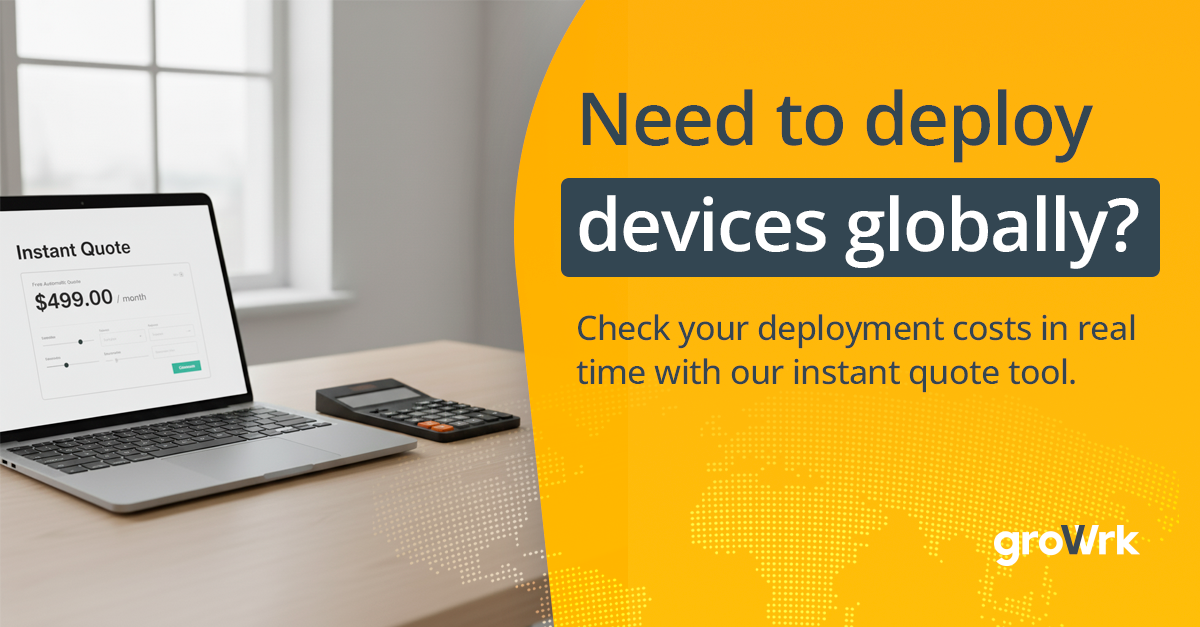Effective inventory sourcing strategies for IT teams
 GroWrk Team
GroWrk Team
Effective inventory sourcing is more than just finding the lowest price—it’s a core function of modern supply chains. According to PwC, 35% of procurement teams now rank sourcing as a top strategic priority, recognizing its impact on cost, innovation, and resilience.
For IT teams managing hardware rollouts or remote equipment needs, sourcing means building reliable supplier relationships, negotiating terms, and maintaining consistent stock levels—all without overspending or delays.
This blog covers key sourcing methods, supplier selection tips, and the tools IT leaders need to simplify and scale their inventory sourcing process.
Key takeaways
-
Effective inventory sourcing involves selecting the right suppliers and methods to optimize costs, minimize inventory expenses, improve cash flow, and enhance customer satisfaction.
-
Sourcing methods include direct from manufacturers, wholesalers, dropshipping, and online marketplaces—each with its own benefits.
-
Utilizing technology, such as inventory management software and data analytics, enhances sourcing accuracy and enables real-time tracking of inventory value.
What is inventory sourcing?

Inventory sourcing is the process of identifying, evaluating, and managing relationships with suppliers who provide the raw materials, components, or finished goods necessary for your business to operate. It’s a critical part of supply chain management that directly affects cost, product availability, and operational efficiency.
Inventory management refers to all the stock a company holds, including raw materials, work-in-progress (WIP), and finished goods. It’s classified as a current asset on the balance sheet and plays a direct role in meeting customer demand and driving revenue.
A strong sourcing strategy enhances procurement workflows, reduces inventory holding costs, and helps prevent issues such as stockouts or overstocking. Whether you're building products or managing a distributed workforce, efficient inventory sourcing ensures you have what you need, when you need it.
Get an instant quote
Key methods of inventory sourcing
.png?width=600&height=300&name=inventory%20sourcing%20(1).png)
The way you source inventory can shape everything from your cash flow to delivery speed. Each method has its own strengths and trade-offs depending on your business size, model, and operational complexity.
-
Direct from manufacturers: Buying directly from manufacturers eliminates intermediaries and reduces unit costs. This approach offers better control over product quality and lead times, but usually requires bulk purchasing and higher upfront investment.
-
Wholesalers and distributors: Wholesalers serve as intermediaries who buy in bulk and sell in smaller quantities. This option offers more flexibility than direct sourcing and is ideal for businesses that require a diverse inventory without incurring large capital expenditures.
-
Dropshipping: This method enables businesses to sell products without maintaining any inventory. Items are shipped directly from suppliers to customers. This reduces financial risk and warehouse costs, but limits control over fulfillment speed and product quality.
-
Online marketplaces: Platforms such as Alibaba, Amazon Business, and eBay provide access to a diverse range of suppliers and competitive pricing. While convenient, sourcing from marketplaces requires careful vetting to ensure reliability and consistency of products.
-
Trade shows: Attending industry trade shows provides opportunities to discover new products, meet suppliers face-to-face, and assess quality firsthand. It's also a valuable way to understand trends and negotiate better terms through relationship building.
Effective inventory management practices
.png?width=600&height=300&name=inventory%20sourcing%20(2).png)
Sourcing the right products is only part of the equation—managing inventory effectively is what ensures long-term profitability. These strategies help balance supply and demand, minimize waste, and support operational efficiency.
-
Demand forecasting: Use historical sales data, predictive analytics, and seasonal trends to project future demand. Accurate forecasting helps align sourcing with actual needs, reducing the risk of overstock or stockouts.
-
Safety stock: Maintain a buffer of inventory to account for supply chain delays or sudden demand spikes. This ensures order fulfillment even during disruptions, without unnecessarily inflating carrying costs.
-
Reorder points: Set inventory thresholds that trigger restocking. Reorder points are based on lead times and average sales velocity, helping automate replenishment and prevent costly gaps in availability.
-
Inventory turnover ratio: Monitor how frequently your inventory is sold and replaced. A healthy turnover rate indicates efficient inventory use, while a low ratio could signal overstocking or slow-moving products.
-
Cycle counting: Perform regular inventory audits by counting a subset of items in rotation rather than shutting down operations for a full count. This ensures accurate records and reduces shrinkage over time.
Selecting reliable suppliers
.png?width=600&height=300&name=inventory%20sourcing%20(3).png)
A strong sourcing strategy starts with choosing the right suppliers. The right partners help ensure steady inventory flow, cost control, and product quality—key factors in meeting customer expectations and business goals.
-
Research and vetting: Start by identifying potential suppliers through directories, trade shows, or referrals. Evaluate their reputation, financial stability, production capacity, and ability to meet quality standards. Test samples, review references, and assess communication responsiveness.
-
Negotiation: Negotiate contract terms that strike a balance between price, quality, and delivery timelines. Clarify expectations around minimum order quantities, lead times, and return policies. Strong negotiations can reduce costs while building a foundation for long-term collaboration.
-
Building long-term relationships: Reliable suppliers become strategic partners over time. Establish open communication channels, share demand forecasts, and collaborate on planning. Trust-based relationships help reduce risk, improve supply continuity, and increase flexibility during disruptions.
Challenges and solutions in inventory sourcing
.png?width=600&height=300&name=inventory%20sourcing%20(4).png)
Even the best sourcing strategy can run into roadblocks. From unpredictable costs to supplier delays, businesses must be prepared to manage common challenges in sourcing. Here’s how to stay ahead:
| Challenge | Description | Solution |
|---|---|---|
| Supplier reliability | Delayed shipments, quality issues, or communication breakdowns can disrupt your supply chain. | Diversify your supplier base, conduct regular performance audits, and maintain safety stock to buffer against disruptions. |
| Price volatility | Fluctuating raw material or shipping costs can eat into margins and make planning difficult. | Lock in pricing through long-term contracts, explore bulk discounts, and use forecasting tools to spot trends early. |
| Logistics complexity | Cross-border shipping, customs delays, and fragmented fulfillment processes can slow inventory flow. | Partner with suppliers that offer flexible logistics, use real-time tracking, and adopt just-in-time delivery models where feasible. |
| Communication gaps | Misaligned expectations or poor updates lead to errors and delays. | Establish clear communication protocols, use centralized platforms for updates, and document all sourcing agreements thoroughly. |
Best practices for sourcing
Sourcing success goes beyond price negotiation. It’s about building a resilient, efficient, and scalable supply chain. These best practices help strengthen supplier relationships and safeguard operations:
| Focus area | Challenge | Best practice |
|---|---|---|
| Cultural considerations | Miscommunication in cross-border partnerships can strain relationships. | Learn local customs, time zones, and communication styles to foster long-term collaboration. |
| Compliance & regulations | Noncompliance with trade laws risks fines, shipment delays, or legal issues. | Stay current on international regulations and work with suppliers that meet global compliance standards. |
| Risk management | Political instability, disasters, or supply chain shocks can disrupt sourcing. | Diversify your supplier base, perform risk assessments, and use contingency planning. |
| Transparent contracts | Vague or unclear terms can create confusion and disputes. | Define pricing, timelines, penalties, and expectations clearly in written agreements. |
| Sustainability alignment | Growing ESG mandates require responsible sourcing practices. | Choose vendors that prioritize ethical labor, eco-friendly materials, and traceability. |
Leveraging technology for inventory sourcing
Technology plays a critical role in streamlining sourcing operations, reducing errors, and improving decision-making. From automation to data-driven insights, the right tools can turn sourcing from a reactive process into a strategic advantage.
Inventory Management Software
-
Tracks stock levels in real time to avoid over-ordering or stockouts.
-
Automates reordering based on predefined thresholds or reorder points.
-
Reduces manual errors and frees up time for strategic tasks.
E-Procurement Systems
-
Automates supplier evaluation and contract workflows.
-
Simplifies sourcing approvals, bid comparisons, and purchase requests.
-
Improves supplier communication and speeds up procurement cycles.
Data Analytics
-
Identifies supplier performance trends and spend patterns.
-
Provides real-time insights into sourcing costs, delivery timelines, and risks.
-
Enables better forecasting and strategic sourcing decisions.
Simplify inventory sourcing with GroWrk
Sourcing IT equipment across locations doesn’t have to involve endless emails, spreadsheets, and vendor juggling. GroWrk brings everything under one roof—so your team can move faster, spend smarter, and stay in control.
Here’s how GroWrk transforms your sourcing process:
-
Global sourcing on one platform
Source and ship laptops, peripherals, and accessories in 150+ countries—without managing multiple vendors or customs paperwork. -
Automated procurement workflows
Trigger equipment orders directly from your HR or IT systems, reducing manual steps and ensuring every request is tracked and fulfilled. -
End-to-end vendor coordination
GroWrk handles supplier negotiations, lead times, and logistics—so you don’t have to chase down shipments or manage delays. -
Real-time inventory visibility
Track sourcing, stock levels, and asset locations from a single dashboard. Get alerts when inventory runs low or when orders hit bottlenecks. -
Built-in compliance and audit logs
Every order and movement is logged—supporting secure sourcing, regulatory compliance, and ESG reporting goals.
Tired of delays, stockouts, and siloed sourcing processes? Book a demo and see how GroWrk helps you scale global IT operations without the stress.
Frequently asked questions
What is inventory sourcing?
Inventory sourcing is the process of identifying, evaluating, and managing suppliers to obtain the goods or raw materials a business needs. It’s a core function of supply chain management that impacts cost, availability, and operational efficiency.
What are the main methods of inventory sourcing?
Common methods include:
-
Direct from manufacturers (cost-effective but high volume)
-
Wholesalers/distributors (flexibility with product range)
-
Dropshipping (low upfront investment, longer fulfillment)
-
Online marketplaces (wide selection and competitive pricing)
How does inventory sourcing affect business performance?
Good sourcing practices reduce costs, improve cash flow, minimize stockouts or overstocking, and strengthen customer satisfaction by ensuring timely product availability.
What role does technology play in inventory sourcing?
Tools like inventory management software, e-procurement systems, and analytics platforms help automate sourcing, improve accuracy, track supplier performance, and streamline workflows.
What’s the difference between inventory sourcing and procurement?
Inventory sourcing focuses on selecting and managing suppliers for stock acquisition. Procurement includes broader purchasing activities such as negotiating contracts, issuing purchase orders, and managing vendor relationships.
How do I evaluate if a supplier is reliable?
Check their delivery history, product quality, communication responsiveness, and customer reviews. It's also a good idea to request samples, review their certifications, and perform regular audits.






